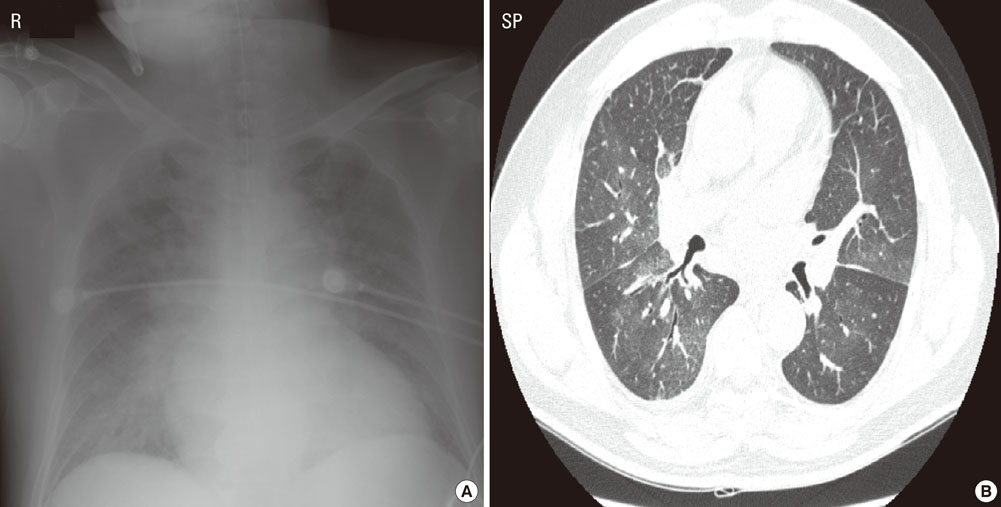Allergy Asthma Immunol Res.
2011 Oct;3(4):280-282. 10.4168/aair.2011.3.4.280.
Bronchospasm and Anaphylactic Shock Following Lidocaine Aerosol Inhalation in a Patient with Butane Inhalation Lung Injury
- Affiliations
-
- 1Division of Allergy and Respiratory Medicine, Department of Internal Medicine, Soonchunhyang University Bucheon Hospital, Bucheon, Korea. jas877@schmc.ac.kr
- KMID: 2167081
- DOI: http://doi.org/10.4168/aair.2011.3.4.280
Abstract
- Allergic reactions to local anesthetics are very rare and represent <1% of all adverse local anesthetics reactions. A 54-year-old man was admitted to the hospital in the winter because of shortness of breath. The patient reportedly had an inhalation lung injury due to butane gas fuel. On the fifth day, he developed an asthmatic attack and anaphylactic shock immediately after lidocaine aerosol administration to prepare for bronchoscopy to confirm an acute inhalational lung injury diagnosis. Cardiopulmonary resuscitation was performed immediately after respiratory arrest, and the patient was admitted to the intensive care unit intubated and on a ventilator. He was extubated safely on the third post-cardiopulmonary resuscitation day. These observations suggest that aerosol lidocaine anesthesia may cause airway narrowing and anaphylactic shock. Practitioners should be aware of this potential complication. We report on this case with a brief review of the literature.
Keyword
MeSH Terms
Figure
Cited by 2 articles
-
Lidocaine anaphylaxis and lidocaine-specific immunoglobulin E measurement
Jin Yeop Yeo, Gyung Eun Kim, Ju Young Han, Jae Hyoung Im, Sung Wook Park, Cheol-Woo Kim
Allergy Asthma Respir Dis. 2013;1(1):98-101. doi: 10.4168/aard.2013.1.1.98.Anaphylactic reaction after local lidocaine infiltration for retraction of retained teeth
Hyerim Kim, Jung-Man Lee, Kwang-Suk Seo, Seok Min Kwon, Hyung Sang Row
J Dent Anesth Pain Med. 2019;19(3):175-180. doi: 10.17245/jdapm.2019.19.3.175.
Reference
-
1. Fuzier R, Lapeyre-Mestre M, Mertes PM, Nicolas JF, Benoit Y, Didier A, Albert N, Montastruc JL. French Association of Regional Pharmacovigilance Centers. Immediate- and delayed-type allergic reactions to amide local anesthetics: clinical features and skin testing. Pharmacoepidemiol Drug Saf. 2009. 18:595–601.2. Mertes PM, Laxenaire MC. Allergic reactions occurring during anaesthesia. Eur J Anaesthesiol. 2002. 19:240–262.3. Laxenaire MC, Mertes PM. Groupe d'Etudes des Réactions Anaphylactoïdes Peranesthésiques. Anaphylaxis during anaesthesia. Results of a two-year survey in France. Br J Anaesth. 2001. 87:549–558.4. Schatz M. Skin testing and incremental challenge in the evaluation of adverse reactions to local anesthetics. J Allergy Clin Immunol. 1984. 74:606–616.5. Ebo DG, Fisher MM, Hagendorens MM, Bridts CH, Stevens WJ. Anaphylaxis during anaesthesia: diagnostic approach. Allergy. 2007. 62:471–487.6. Cuesta-Herranz J, de las Heras M, Fernández M, Lluch M, Figueredo E, Umpierrez A, Lahoz C. Allergic reaction caused by local anesthetic agents belonging to the amide group. J Allergy Clin Immunol. 1997. 99:427–428.7. Astarita C, Gargano D, Romano C, Cutajar M, Manguso F, Montanaro D, Napolitano A, Pezzuto F, Lo Schiavo M, Altucci P, Abbate G. Long-term absence of sensitization to mepivacaine as assessed by a diagnostic protocol including patch testing. Clin Exp Allergy. 2001. 31:1762–1770.8. Gall H, Kaufmann R, Kalveram CM. Adverse reactions to local anesthetics: analysis of 197 cases. J Allergy Clin Immunol. 1996. 97:933–937.9. Ramsey J, Anderson HR, Bloor K, Flanagan RJ. An introduction to the practice, prevalence and chemical toxicology of volatile substance abuse. Hum Toxicol. 1989. 8:261–269.10. In JH, Choi JW, Joo JD, Kim DW, Jung HS, Park HJ. Intraoperative anaphylaxis after local infiltration of lidocaine for dental treatment under general anesthesia -A case report. Korean J Anesthesiol. 2008. 55:395–398.



